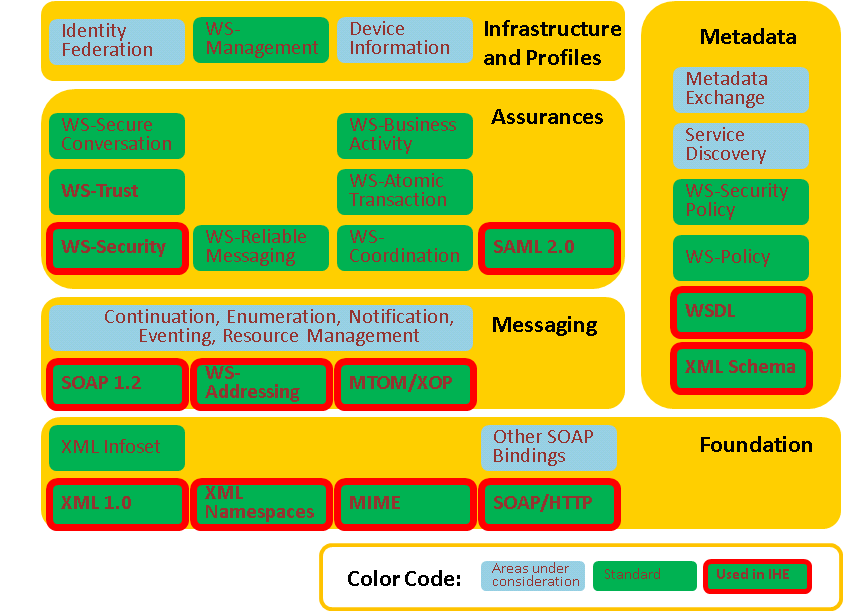Difference between revisions of "IHE ITI Web Services Glossy"
| Line 7: | Line 7: | ||
==The Role of Web Services in Health Care Interoperability== | ==The Role of Web Services in Health Care Interoperability== | ||
As with any other technology, the use of web services has benefits and costs. It is important to understand where web services fit in the overall framework for the meaningful exchange of health care information, which is the basis of health care interoperability. The ''what'' and ''how'' of that exchange is sometimes described as semantic and syntactic interoperability. Standards-based web services provide a SOAP-based messaging infrastructure and transport mechanism, which are important pieces of the syntactic interoperability puzzle. | As with any other technology, the use of web services has benefits and costs. It is important to understand where web services fit in the overall framework for the meaningful exchange of health care information, which is the basis of health care interoperability. The ''what'' and ''how'' of that exchange is sometimes described as semantic and syntactic interoperability. Standards-based web services provide a SOAP-based messaging infrastructure and transport mechanism, which are important pieces of the syntactic interoperability puzzle. | ||
| + | |||
| + | Web services are applicable to a variety of use cases, workflows, and business contexts. This flexibility is provided by the ability to layer various web services components on top of each other. Among the benefits of such general applicability are reusability of tools, reusability of established infrastructure, gradual implementation of features, and gradual specification of features. At the same time, among the costs of generality are implementation of the underlying infrastructure, and handling the relative heavy-weight payload of web services transactions. | ||
| + | |||
| + | <<''Add an illustration of layering of web services''>> | ||
| + | |||
| + | IHE strives to evaluate the trade-off between benefits and costs of using web services protocols as the underlying infrastructure for IHE transactions, and provides specificity in order to reduce the generality of the existing standards. The latter uses a similar approach as WS-I in profiling web services specifications. As various | ||
==Use of Web Services Across existing IHE Profiles== | ==Use of Web Services Across existing IHE Profiles== | ||
==Applying Web Services to the creation of new IHE Profiles== | ==Applying Web Services to the creation of new IHE Profiles== | ||
Revision as of 10:59, 28 March 2008
Introduction
Web services can be commonly defined as a set of protocols, which are based upon the computer network technology powering the World Wide Web. The goal of implementing web services is to provide a stable, vendor neutral infrastructure platform for data exchange, upon which various products can differentiate themselves by providing value added benefits. This allows better interoperability among systems, which benefits both users, and vendors. From the user's perspective, a vendor-neutral infrastructure allows them to chose the best systems to serve their needs. From the vendor's perspective, using a standards-based and platform-neutral technology lets them concentrate on their core competencies, and lowers the cost of research and development.
The web services standards are developed in two main SDOs: the Organization for the Advancement of Structured Information Standards (OASIS), and the World Wide Web consortium (W3C). These standards are designed to work with each other, and build upon each others' features. The Web Services Interoperability organization (WS-I) further profiles existing standards and provides validation tools to ensure interoperability between implementations. The following illustration provides a view on the various Web Services and the relationship among them:

The Role of Web Services in Health Care Interoperability
As with any other technology, the use of web services has benefits and costs. It is important to understand where web services fit in the overall framework for the meaningful exchange of health care information, which is the basis of health care interoperability. The what and how of that exchange is sometimes described as semantic and syntactic interoperability. Standards-based web services provide a SOAP-based messaging infrastructure and transport mechanism, which are important pieces of the syntactic interoperability puzzle.
Web services are applicable to a variety of use cases, workflows, and business contexts. This flexibility is provided by the ability to layer various web services components on top of each other. Among the benefits of such general applicability are reusability of tools, reusability of established infrastructure, gradual implementation of features, and gradual specification of features. At the same time, among the costs of generality are implementation of the underlying infrastructure, and handling the relative heavy-weight payload of web services transactions.
<<Add an illustration of layering of web services>>
IHE strives to evaluate the trade-off between benefits and costs of using web services protocols as the underlying infrastructure for IHE transactions, and provides specificity in order to reduce the generality of the existing standards. The latter uses a similar approach as WS-I in profiling web services specifications. As various